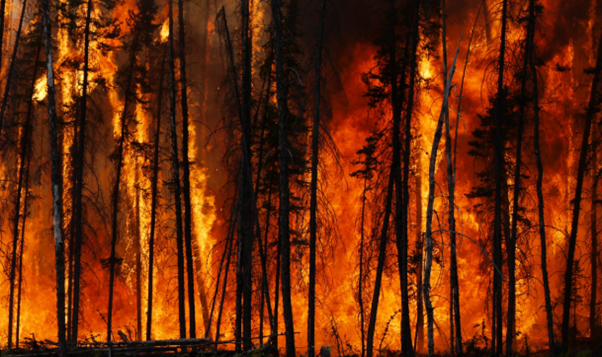Wildfires release a dangerous cocktail of pollutants: particulate matter (PM2.5 and PM10), carbon monoxide, nitrogen oxides, volatile organic compounds, and black carbon. Among these, PM2.5—the ultrafine particles less than 2.5 microns in diameter—has gained notoriety for its deep penetration into the human respiratory tract, even entering the bloodstream to affect multiple organs. The primary health concern is that these particles bypass many of the body’s natural defenses, causing acute and chronic harm.
More regions now face extended and more severe fire seasons. Areas such as California, western Canada, Australia, Brazil, southern Europe, and northern India regularly report record-breaking wildfires. In many countries, wildfires now contribute a significant share of annual PM2.5 pollution, often offsetting years of progress made in reducing air pollution from cars and industry. The fire seasons of recent years—Australia in 2019-2020, Canada in 2023-2024, Russia, Greece, and the United States—were notable for the amount of smoke that blanketed entire cities, disrupting daily life and straining hospital systems.
How Wildfire Smoke Travels and Transforms
The reach of wildfire smoke extends hundreds or even thousands of kilometers beyond the original blaze. Atmospheric currents can transport particulate matter across provincial, national, and even continental boundaries, turning clear blue skies into post-apocalyptic orange or grey. For example, wildfire smoke from Canadian forests has traveled into the US Midwest, drastically increasing PM2.5 concentrations in cities like St. Louis and Chicago and pushing the Air Quality Index (AQI) into hazardous territory.
Long after the last ember is extinguished, chemical reactions in the atmosphere may continue to transform the smoke’s composition, prolonging exposure to harmful pollutants for millions of people. This transformation makes wildfire-related PM2.5 especially dangerous—studies show that the chemical makeup of these particles can be more toxic than urban PM2.5, compounding health risks.
The Health Burden: Respiratory Illness and Beyond
Wildfire smoke is primarily composed of fine particulate matter that, when inhaled, can cause inflammation, oxidative stress, and immune dysfunction. The clearest evidence connects wildfire-related PM2.5 to a dramatic uptick in respiratory illnesses. Hospitalizations for asthma, chronic obstructive pulmonary disease (COPD), and all-cause respiratory distress spike during and after major wildfire events. Nationwide studies across North America, Australia, Brazil, and Asia confirm that short-term exposure to even small increases in wildfire PM2.5 leads to higher rates of:
- Acute and chronic asthma attacks
- Exacerbation of existing respiratory diseases (COPD, bronchitis, pneumonia)
- Upper respiratory tract infections and irritation
- Lower respiratory illnesses, including flu and pneumonia, with increased severity.
Data from major wildfire episodes reveal an increase in emergency room visits and hospital admissions, especially among groups already vulnerable to poor air quality: children, the elderly, and those with preexisting lung or heart disease. In some cases, the number of hospitalizations attributed to wildfire-specific PM2.5 is ten times higher than that from PM2.5 generated by other sources, highlighting the severe threat this pollutant poses.
But the damage isn’t limited to the lungs. Wildfire-related air pollution is associated with heart attacks, strokes, eye and skin irritation, and even cognitive impairment. Congregations of PM2.5 from wildfires can trigger systemic inflammation that increases the risk of cardiovascular events, neurological deficits, and aggravates chronic illnesses.
Vulnerable Groups: Children, Elderly, Pregnant Women, and the Poor
Certain populations are at greater risk for serious adverse health outcomes from wildfire smoke. Children’s developing lungs are more sensitive to air quality, making them especially prone to asthma flare-ups and potentially longer-term respiratory damage. The elderly, often living with pre-existing respiratory or cardiovascular ailments, experience higher hospitalization and mortality rates during smoke events.
Pregnant women exposed to elevated PM2.5 from wildfire smoke have a demonstrably higher risk of preterm birth, as found in studies spanning North America and Brazil. Some evidence suggests that the highest risk occurs with exposure during the second trimester, emphasizing the need for targeted interventions and guidance for expecting mothers during fire season.
Low-income communities, rural populations near forests, and those lacking access to well-sealed dwellings or air filtration are more exposed to both smoke and its most toxic components. The ability to reduce exposure by leaving the affected area or using expensive air purifiers is not evenly distributed, amplifying disparities in health outcomes linked to socioeconomic status.
The Overlap with Respiratory Viruses and Pandemic Threats
Adding to the complexity, wildfire smoke exposure often coincides with transmission of respiratory viruses such as COVID-19, influenza, and RSV. Both the particulate pollution and respiratory viruses independently damage respiratory and immune systems, but emerging research shows their co-occurrence leads to worse outcomes. People exposed to smoke are not only more likely to contract respiratory viruses but may also face a higher risk of complications, hospitalization, and death. These findings suggest that protecting public health during wildfire events has become even more urgent in the post-pandemic world.
The Climate Feedback Loop: Vicious and Self-Reinforcing
Wildfires are a direct manifestation of climate change, but they also drive climate change further. Burning forests release massive quantities of CO2 and methane—greenhouse gases that warm the planet, creating the very hot and dry conditions that fuel even more fires. This feedback loop makes wildfires both a result and a cause of the planetary crisis. As more carbon is injected into the atmosphere, society faces a greater likelihood of additional, more intense fires, and, by extension, more air pollution.
Disruption Beyond Health: Economy, Society, and Daily Life
The impact of devastating wildfires stretches beyond physical health. Dense smoke disrupts transportation, closes schools, cancels flights, delays deliveries, and halts construction. Visibility on roads drops, increasing accidents. Rural livelihoods based on agriculture and tourism suffer acutely.
People are forced indoors, but even within homes and workplaces, levels of indoor PM2.5 can remain alarmingly high—unless expensive, HEPA-standard air filtration is in place. Economies absorb billions in damages related to lost productivity, emergency medical costs, fire mitigation efforts, and rebuilding destroyed infrastructure.
Addressing the public health impacts of wildfire smoke requires action on many fronts:
- Governments should enforce strict air quality monitoring, provide real-time alerts, and prioritize protective interventions for vulnerable groups during fires.
- Urban planning should embrace the creation of clean air shelters, robust emergency health services, and fire-safe infrastructure for at-risk communities.
- Health systems must develop integrated response plans that link air pollution tracking with medical readiness, especially allowing rapid response to rising respiratory hospitalizations.
- Individuals should be prepared with N95 masks, home air filtration, sealed environments, and access to real-time air quality information during fire seasons.
- Long-term action, crucially, hinges on climate change mitigation—reducing greenhouse gas emissions to limit the worst fire seasons and their cascading health impacts.
Continued research and international collaboration will be critical. Recent multi-country studies show the universality of wildfire PM2.5 threats but also illuminate regional variations based on geography, socioeconomic status, and health infrastructure. Integrating these insights into public health strategies can drastically reduce the toll that wildfires take on communities around the world.
With climate projections warning of ever-more challenging fire seasons, confronting the health risks of wildfire-related air pollution is both a scientific and moral imperative. Cleaner energy sources, sustainable land management, and proactive investment in public health can disrupt the cycle, saving lives and securing healthier air for future generations.
The age of megafires is upon us, but with knowledge, preparation, and decisive action, societies can counteract the silent siege of smoke and protect the world’s most vulnerable from its invisible dangers.



